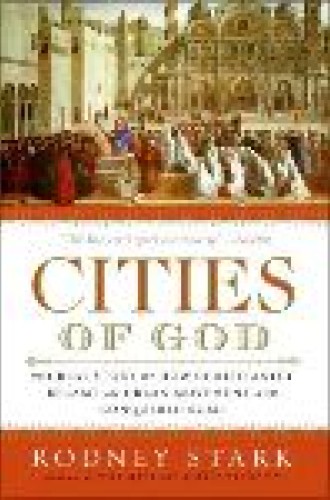Cities of God: The Real Story of How Christianity Became an Urban Movement and Conquered Rome
This book is part of the saga begun in Stark’s provocative The Rise of Christianity (1996). It features more sociological and statistical arguments than the earlier book but contains startling conclusions that encourage the reader to press on.
Here are a few: Although the apostle Paul’s epistles formed aspects of Christian faith, he did not make a lot of converts. The churches he planted were tiny and experienced little growth until his new converts were winning their neighbors. Most Christians were urban; some dismissed rural populations as barbarians incapable of salvation. Christians created a “miniature welfare state” that the ancient world did not previously have, but their primary concern was religion. Plato and others had made monotheism attractive, but the victor was the one supreme Christian God who called people to invest their religious capital with him. Christianity never experienced large group conversions, but it could have gained over 31 million adherents by the year 350 if numbers increased by merely 3.4 percent a year.
Stark found that paganism was a stronger, more diverse opponent than he had previously thought. Over 500 years before Christ, Hesiod had claimed that there were 30,000 distinct gods, and some of their temples were still open in the fifth century AD. Furthermore, paganism was not always tolerant; the Romans outlawed the cult of Isis in 54 BC. Greco-Roman religions were exceptionally cold and were never supported by the rank and file. The Eastern mystery religions, however, were of a different quality. A number of them involved feasting, making music, burning incense and dancing. They appealed to every human sense— including the intellect—to draw converts in.
Followers of both Cybele and Mithras had a sacred meal similar to the Christian Eucharist. Justin Martyr and Tertullian said demons had copied the Christian sacrament, but for John Chrysostom, the common meal of Cybele was yet another example prepared by God so the difficult truth of Christ could eventually be understood. Isis even had a redemption story that corresponded to that of Christianity. Before the reign of Emperor Julian in the fourth century AD, pagans and Christians in numerous places lived relatively peacefully together, but after Julian’s incessant attacks on Christianity, more rabid Christians moved against pagans with a vengeance.
Stark shows that statistical studies of earliest Christianity can make the historical picture clearer and more reliable. Looking at 31 cities with populations of over 30,000, he notes that Christianity first moved to places close to Jerusalem with strong Jewish communities, but soon went to Hellenic ports and larger cities as well as small towns. In larger places they met not only Jews but also Greco-Roman pagans and followers of Eastern religions such as the cults of Cybele and Isis. Heretical schools tended to avoid the Jewish diaspora and were not where Christianity first emerged. Montanists operated in large cities that did not have heretical schools. Manichees and Valentinians, on the other hand, were in large cities with heretical schools.
In terms of numbers, Paul’s churches were small, but many of Christianity’s best pioneer missionaries have faced such difficulties. How much did their plowing prepare the field for the contextualized seed they planted? Paul was a Jewish apologist who definitely held his own with Jews and gentiles, and his theology is still widely followed. Although he was not a church-growth star, he was a significant evangelist. That is true of important missionaries today.
A few quibbles. First, is there really no evidence of mass conversions? The book of Acts mentions a conversion of “about 3,000 persons.” In late antiquity Germanic tribes and sizable groups in Armenia, Ethiopia, Georgia and Yemen joined as nearly whole communities, often following a king’s conversion. Tribal societies in modern times have done the same. Stark’s statistical concerns block his acceptance of what has occurred. Christianity might have grown by only 3.4 percent a year, but it might have grown more quickly at times.
Second, Stark’s understanding of salvation is constricted. Salvation is individual for him. Christianity’s dealings with the sick, the poor, the widows and so on are a part not of salvation but of meeting social needs. But many of Jesus’ parables indicate that concern for others is basic to kingdom life. When salvation is communal, identity is properly communal. An African variation on Descartes’s “I think therefore I am” comes to mind: “I am because we are.”
Finally, Stark’s insistence that monotheism always wins out is overly optimistic. It is true that monotheistic religions such as Islam and Christianity are on the move and that Buddhism is experiencing difficulties in Korea and perhaps elsewhere, but it is still growing in the West and attracts Westerners to the East, while Hinduism has established itself in the U.S., particularly through immigrants who work in medicine. Both of those religions still have appeal, and it was not long ago that Hinduism experienced a remarkable revival in India.
Stark’s conclusion that Christianity was urban and did not retreat to rural settings but witnessed alongside Jews, Greco-Roman pagans, Christian heretics and followers of Eastern religions is a solid lesson for contemporary Christians. Enjoy the cities. Live the virtuous life within them and make the case for the faith.





